Getting Pumpkin Blossoms – Why A Pumpkin Plant Is Not Flowering


Your pumpkin vines are scrambling all over the place, with huge healthy leaves and vigorous growth. Sadly though, there is nary a bloom in sight. If you are concerned about non-blooming pumpkin plants, you may simply have looked away for a day or it is too early. Some other considerations are soil nutrients and possible diseases. Don’t fret, there are some tricks to getting pumpkin blossoms and harvesting big, beautiful fruit. Fertilizers and some homemade sprays may be just the tip on how to get blooms on pumpkins that are reticent to flower.
My Pumpkin Plant is Not Flowering
What could cause non-blooming pumpkin plants? The most common reason is impatience. Pumpkin plants flower after plants have established and developed several vital stems. When do pumpkin plants flower? The actual time will depend upon when you installed them outdoors, the variety, and your climate. As a rule, start looking for blooms six to eight weeks after you set the plants outside. Next, let’s talk about sex – between flowers that is. Pumpkin plants bear both male and female flowers (same as squash) and each is necessary for pollination and fruit. The first flowers to appear are male blooms. Females follow 10 to 14 days later. If you do not see any flowers, it may simply be because you are not looking often enough. Each bloom lasts only a day and is generally only open in the morning. The early male flowers will usually fall off almost immediately if no females are present to pollinate. You have to have a sharp eye to spot the earliest flowers. Amid the tangled mass of stems, it is easy to overlook some flowers. You might also be expecting flowers too early. Vines should be several feet (1 m.) long before the first bright yellow flowers appear. Answering the question, “when do pumpkin plants flower?” requires knowledge of soil, sun exposure, zone, variety, and many more factors. Each influences the plant’s drive to bloom. You can enhance blooming by controlling soil fertility and giving the plant additional nutrients that promote flowering. Pumpkin plants are very sensitive to overhead watering. Several fungal diseases can attack the leaves and even the buds as they form. Heavily infested buds may simply abort, leaving you with a bloomless plant. Soil fertility is a common reason when a pumpkin plant is not flowering. While potassium is the macro-nutrient that drives the overall functions of a plant, if it’s lacking, this can affect blooming. It comes in the form of potash or other potassium compounds found in flower and fruit food. Phosphorus is generally responsible for flower and fruit production. Suspend nitrogen applications six to eight weeks after planting the vines. In soils with plenty of organic matter, the vines should have enough nutrients to produce the rampant stems.
How to Get Blooms on Pumpkins
Getting pumpkin blossoms on reticent plants can be achieved with fertilizer. Controlling the level of nitrogen, potassium, and phosphorus will spur flower production. Nitrogen produces green leafy growth while phosphorus drives root formation and bloom production. Potassium also aids with blooming but helps plants develop healthy immune systems for stronger growth too. Professional flower growers rely upon “bloom foods” containing high levels of phosphorus and potassium to grow award winning flowers. Amending the soil with some potash and/or bone meal OR applying a high phosphorus/potassium plant food (foliar spray or granular feed) could help the plant start pumping out flowers. Be patient because the magic won’t happen overnight. After feeding, give the plant a week or more to uptake the food and use it to create buds, flowers, and, finally, those gorgeous pumpkins.
Sign up for the Gardening Know How newsletter today and receive a free copy of our e-book "How to Grow Delicious Tomatoes".

Bonnie Grant is a professional landscaper with a Certification in Urban Gardening. She has been gardening and writing for 15 years. A former professional chef, she has a passion for edible landscaping.